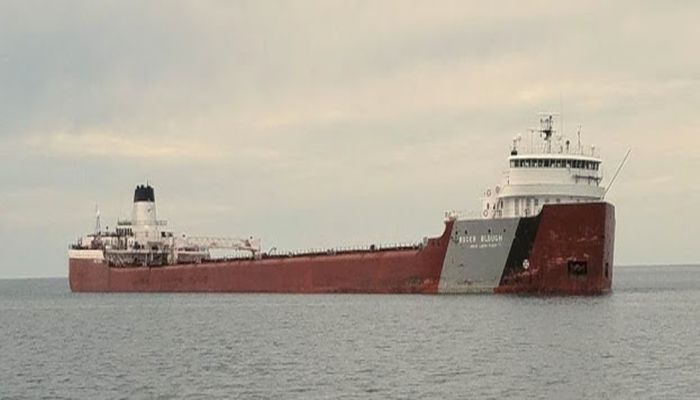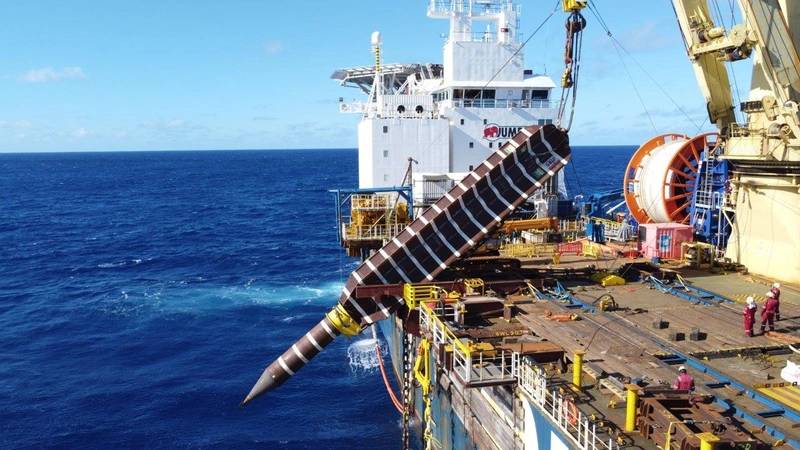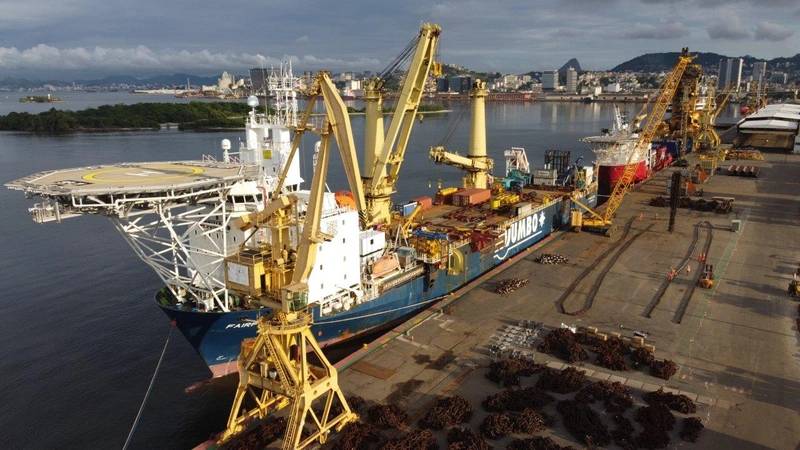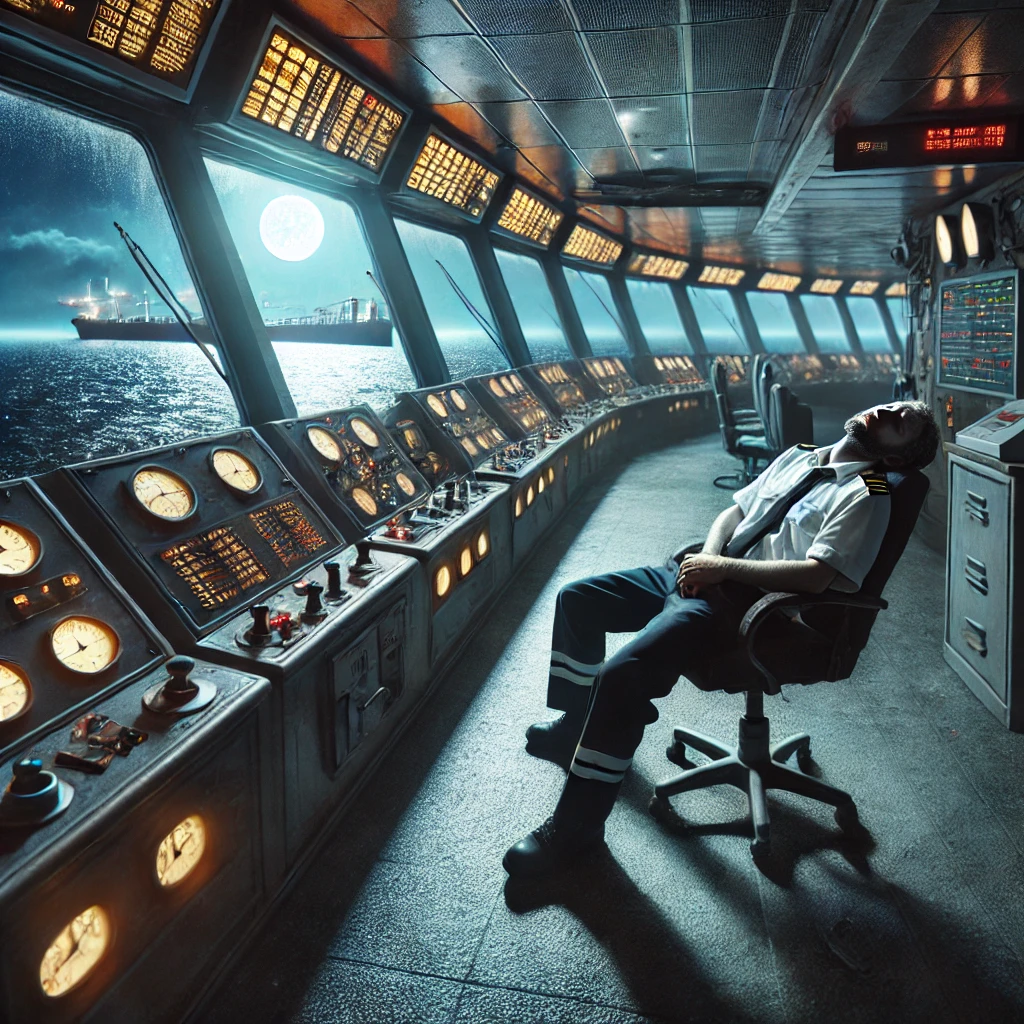The Interlake Steamship Company held a christening ceremony in Cleveland on Thursday for its new vessel, Mark W. Barker, the first U.S.-flagged freighter built on the Great lakes in nearly four decades.
“This is truly a historic celebration for our company and for the United States maritime industry as we proudly christen the newest vessel to join the U.S. flag fleet on the Great Lakes and our first new build in 41 years,” said Mark W. Barker, President of The Interlake Steamship Company and the vessel’s namesake. “While this ship may bear my name, it is a testament to the innovation, skill and grit of our employees who have powered our industry and propelled our Company for more than 130 years.”
Built at Fincantieri Bay Shipbuilding in Sturgeon Bay, Wis, the 639-foot vessel was made from iron ore mined in Minnesota by Cleveland-Cliffs, and carried on U.S.-built, U.S.-crewed, and U.S.-owned Lakers to Cleveland-Cliffs’ Burns Harbor mill in Indiana. There the pellets were forged into steel plates and shipped to the Wisconsin shipyard.
“This American-made vessel is not only a veritable Great Lakes success story, it is a Cleveland ship, through and through,” said Chairman James R. Barker. “Designed to navigate the winding curves of the Cuyahoga River, built with Cleveland-Cliffs steel and coated with Sherwin-Williams paint, the M/V Mark W. Barker was most significantly built as part of a long-term partnership to move Lake Erie-mined salt for Cargill Inc.”
“We are thrilled to partner with The Interlake Steamship Company to connect Cargill’s customers with salt from the Great Lakes region,” said Sonya Roberts, president of Cargill’s salt business. “We are proud to be a part of the Cleveland community and communities across the country that rely on us to deliver products that protect lives and enhance commerce by keeping roads clear in the winter.”
U.S. Rep. Marcy Kaptur (OH-09) served as the keynote speaker at the ceremony that welcomed many federal, state and local dignitaries, as well as industry leaders. Referred to by many as the First Lady of Great Lakes shipping, Congresswoman Kaptur is the longest serving woman in congressional history. Kaptur is joined by U.S. Rep. Shontel Brown (OH-11) and Cleveland Mayor Justin Bibb, who will welcome the crowd to the outdoor Christening event being held next to FirstEnergy Stadium. The culmination of the ceremony will be when Christening Sponsor Megan L. November breaks the bottle of bubbly on the bow.
Great Lakes shipping, which supports nearly 150,000 jobs and represents $35 billion in economic impact, is the most efficient and environmentally responsible form of transportation. This ship will carry an average of 25,000 tons per trip, which is equal to the carrying capacity of 250 train cars, and 1,000 trucks. Notably, the M/V Mark W. Barker is the first ship on the Great Lakes with engines that meet EPA Tier 4 emissions standards.
“This new vessel not only brings with it additional cargo carrying capacity and capabilities, it is the most versatile in our fleet and strategically sized to navigate into nearly any port on the Great Lakes,” said Brendan P. O’Connor, Vice President of Marketing and Marine Traffic. “The M/V Mark W. Barker will give us unmatched ability for cargo operations and to carry unique project cargoes because of her square-shaped cargo holds, her larger hatch openings, reinforced cargo hatches which can support deck cargo, and a forward mounted unloading boom. She truly was designed to be a vessel for the future.”
The new River-Class, self-unloading bulk carrier is believed to be the first ship for U.S. Great Lakes service built on the Great Lakes since 1983. The Jones Act qualified vessel, measuring 639 feet in length, 78 feet in beam, 45 feet in moulded depth and 28,000 dead weight tons, the ship will transport raw materials such as salt, iron ore, and stone to support manufacturing throughout the Great Lakes region. The ship will also be capable of transporting specialty cargoes such as steel coils and windmill towers and blades. The ship is crewed with licensed officers represented by The Marine Engineers’ Beneficial Association (M.E.B.A.) and unlicensed crew represented by United Steelworkers Local 5000.
The Interlake Steamship Company, Fincantieri Bay Shipbuilding (FBS) and Bay Engineering jointly designed the bulk carrier, complete with advanced vessel and unloading system automation. Major partners for the project included: American Bureau of Shipping (ABS); Cleveland-Cliffs, Bay Engineering (BEI); EMD Engines; Caterpillar; EMS-Tech, Inc.; Lufkin (a GE Company), Sherwin-Williams, Kongsberg and MacGregor.
Source: https://www.marinelink.com/news/interlake-steamship-christens-first-new-499147










